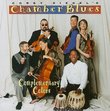| All Artists: Mozart, Bach, Academy of Early Music Berlin Title: Sinfonien Members Wishing: 0 Total Copies: 0 Label: Berlin Classics Release Date: 8/23/1994 Genre: Classical Styles: Historical Periods, Classical (c.1770-1830), Symphonies Number of Discs: 1 SwapaCD Credits: 1 UPC: 782124110420 |
Search - Mozart, Bach, Academy of Early Music Berlin :: Sinfonien
CD DetailsSimilar CDs
|
CD ReviewsA Real Winner Leslie Richford | Selsingen, Lower Saxony | 05/20/2007 (5 out of 5 stars) "Johann Christian Bach (1735 - 1782): Symphony in G Minor Op. 6,6; Symphony in D Major, Op. 18,6; Symphony in D Major, Op. 18,4. Wolfgang Amadeus Mozart (1756 - 1791): Symphony in A Major, K.. 134; Symphony in D Major, K. 181; Curtain Music from "Thamos", K. 345 (336a), No. 5.
Performed by the Akademie für Alte Musik Berlin (Berlin Academy for Ancient Music). Recorded in the studios of Radio Free Berlin (Sender Freies Berlin) in September 1993. Published in 1994 as Berlin Classics BC 1104-2. Total time: 65'23". It seems to be the purpose of this disc to enable a comparison between the orchestral works of Johann Christian Bach, the youngest son of Johann Sebastian, and of Mozart. It is well known that as a child, while touring Europe, Mozart met Johann Christian Bach in London and that they played together. After that time, the young Mozart looked to J. Chr. Bach as something of an example (they both studied with the same Italian teacher, Padre Martini), although Mozart, being a genius, obviously did not just copy the younger Bach's style but re-formed it and made it his own. And so the pieces on this disc come in pairs: first, a three-movement symphony from each of the two composers, then a four-movement symphony from both, then the Curtain Music from Mozart's Thamos and another three-movement symphony from J. Chr. Bach. There are obvious similarities and equally obvious differences; both were great composers, but history has rightly declared Mozart to be the greatest of all. The Academy for Ancient Music here consists of 9 violins, 3 violas, 2 cellos, a double bass, a harpsichord, two each of flute, oboe, bassoon, horn and trumpet with timpani (all historical instruments, but there are no details in the booklet). The fast outer movements are here played with absolutely explosive punch, probably a good deal more of it in fact than could or would have been heard in the 18th century, but that makes the music very exciting, trumpets, drums and horns all contributing to some really captivating moments. But in the slow movements, it is also the winds who seem to carry the day: listen to the Andante and the Allegretto in J. Chr. Bach's Op. 18 No. 6 for some beautiful combinations of flute, oboe and bassoon. You have never heard this music played with so much drive and enthusiasm, and although this may not be quite "authentic" (whatever that means in this context), it makes for sheer entertainment, the kind of music that makes you sit on the edge of your chair when you listen to it. As the engineering is absolutely first class, giving an amazingly good stereo panorama, the disc is a real winner." |




